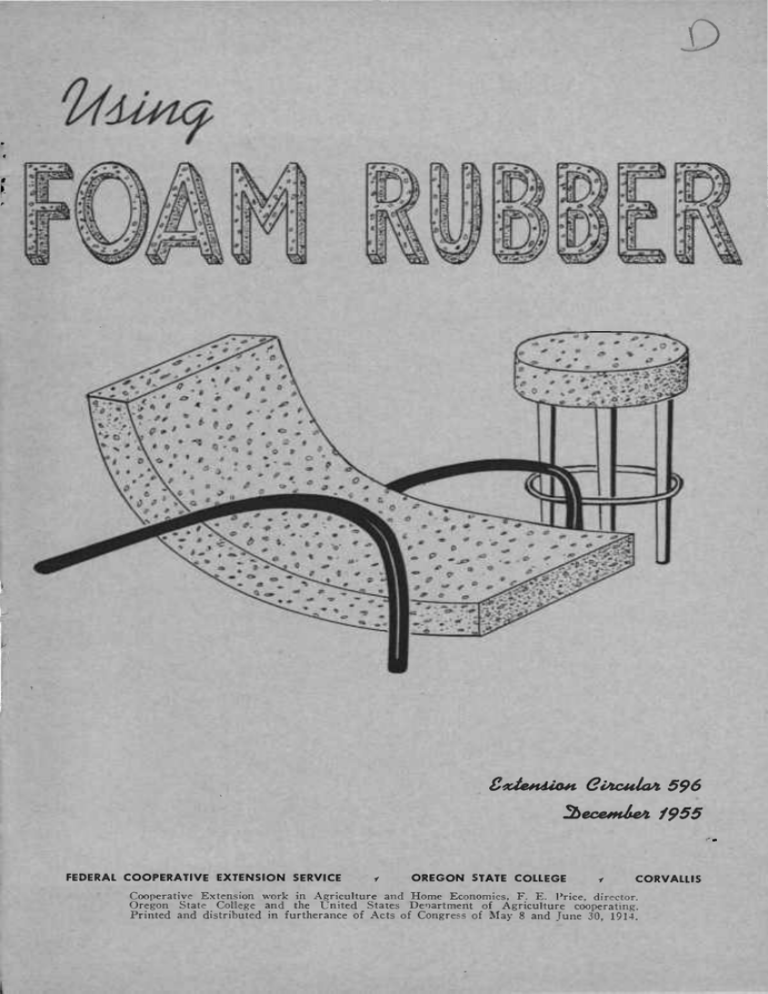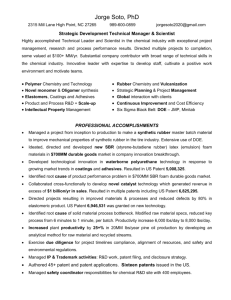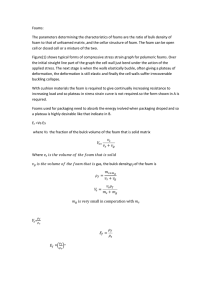:D &^Ue4Uio*t 596 Sbecem&e* 1955
advertisement

:D &^Ue4Uio*t QVICMIO*. 596 Sbecem&e* 1955 FEDERAL COOPERATIVE EXTENSION SERVICE OREGON STATE COLLEGE CORVALLIS Cooperative Extension work in Agriculture and Home Economics, F. E. Price, director. Oregon State College and the United States Denartment of Agriculture cooperating. Printed and distributed in furtherance of Acts of Congress of May 8 and June 30, 1914. Using Foam Rubber Mrs. Myrtle Carter Extension Home Furnishings Specialist T ATEX FOAM RUBBER is bringing -*-' about a new era in cushioning. It is not only bringing you more comfort, but is making modern furniture more streamlined and more lasting. It is now available for use in your home — in readymade mattresses and furniture, and "by-the-yard" for those who wish to make or do over their own home furnishings. Though there was some previous use of foamed latex in foreign countries, it was first produced on a limited scale in this country in 1935. The first applications of this material were in public service equipment — railroad trains, street railways, and in buses. Because of its performance, increased riding comfort, and superior service life, it has become the main cushioning material for public carriers. Although the initial cost is usually higher than other cushioning materials, its over-all cost is less, since it retains its shape. It does not break or mat down, or wear as do other materials. Trade sources report that many cushions and mattresses put in use during the early development of this product are still giving good service, and have retained their shape through the years. Today, you find foam rubber in a wide variety of products; in most passenger car seat cushions, backs, and armrests; in truck seats and heavy road-moving equipment; tractor seats, airplanes, boats, motorcycles, and bicycles. There are many mattresses, pillows, and furniture cushions being used in homes, hospitals, and other institutions. Foam rubber rug pads also are popular. What Is Latex Foam Rubber? Making latex foam is like making a huge cake. Pure latex (the milk of the rubber tree) is collected on rubber plantations, and shipped in liquid form to manufacturers in the United States. Figure 1. The latex is then whipped to a creamy froth in giant mixers. Texture and firmness of the finished material are controlled during the foaming process. The more air bubbles there are, the lighter and softer the finished product. In 1 cubic inch of latex foam there are over 250,000 small air cells. In sheet form, latex foam is about 85% air. When the sheets have molded openings, the material is from 90% to 95% air. When the foamy mixture has reached the right consistency it is poured into metal molds of the desired shape and placed in giant ovens to "bake" under controlled heat and pressure. The cured latex foam is then removed from the ovens, stripped from the molds, washed to remove all impurities, and dried. You can see that both the materials used and the method of processing lend themselves to a long service life. The finished product is a clean, self-venti- lating material, with physical properties that give good cushioning. The reason why latex foam is so light and airy as compared to "sponge rubber" is because the millions of tiny air cells are interconnected so your cushion or mattress literally "breathes" as you move about. The cells in ordinary "sponge rubber" are not interconnected, with the result that odors and heat cannot be scattered. Characteristics of Foam Rubber Cushioning Advantages It's comfortable—soft and resilient, springs back, and always retains its original shape. Absorbs body heat and "exhales" it. It's durable — withstands hard usage over a long period of years. It's lightweight — due to 85% to 95% air content. It's clean—does not absorb dust as it "breathes" through its many air cells. May be cleaned with soap and water. It's allergy free. It resists moths, mildew, and insects. It's neat — no punching, turning, or shaking. Springs back to its original shape. It's easy to handle — a distinct ad- vantage for a beginner. Takes less time, effort, and skill as you can eliminate some of the steps used in conventional methods of reupholstery. Easier to do a professional looking job in upholstery. Disadvantages Current costs — Latex foam is still comparatively expensive. Initial cost, however, is counterbalanced by its excellent wearing qualities, and its ability to combine well with many other materials. Current supply is limited on the retail level. Until two years ago the main outlet was "to the trade" onlymanufacturers of furniture, etc. With time and increased demand, a greater selection should be readily available to the average homemaker. Where to Buy Latex Foam • Department stores • Some variety stores • Mail order houses • Distributors and jobbers of foam rubber • Some upholstery supply houses Uses of Latex Foam Rubber Foam rubber can be used wherever a cushion is needed. Today it is used not only in the transportation field, but in all phases of furnishings for private and public buildings. Loose cushions Mattresses (Full-depth latex foam; latex foam topper pads over innersprings) Regular bed Chaise lounge Crib Bassinet Daybed Baby carriage Outdoor furniture Bolsters Chairs Window seats Benches Bed cushions Sofa cushions (^X Figure 4. Figure 2. Wearing apparel Furniture Chairs Sectionals Sofas Hassocks Loveseats Ottomans Benches (vanity, piano, etc.) Stools (kitchen, bar, bathroom, nursery, etc.) Shoulder pads Bra pads Shoulder strap cushions Slipper soles Shoes and innersoles Arch support and foot padding Miscellaneous Figure 3. Carpet underlay Powder puffs and makeup sponges Suede cleaners Mops and cleaning sponges Bath brushes Toys Knee rests Foam Rubber for Upholstering Foam rubber is available in sheet form (either plain or cored) and in molded forms. Plain sheet stock is the least expensive and has many uses, but it gives less depth and buoyancy than cored stock. You may buy "seconds" that are often quite satisfactory at reduced prices. Plain sheet stock Solid sheet stock, which ranges from ^ inch to 2 inches can be cut to any desired shape. It is used for relatively thin padding. The softness of the piece is referred to as compression or density—soft, medium, firm, or extra firm. For backs and arms use f-inch to l|-inch thickness in soft or medium compression. For seats use f-inch to Figure 5. Figure 6. Cored utility stock. For arms and backs use a medium compression 1| to 2 inches thick. For seats use medium to firm compression. The thickness may vary according to the base. Over springs it should be 2 to 3 inches thick; on webbing or plywood from 1 to 3 inches thick. Cover springs with burlap to prevent rubbing. Drill holes in plywood. Leave spaces between webbing strips. Plain sheet stock. Fully molded cushions 2-inch thickness. Over webbing use medium compression, but do not space strips of webbing more than 1 inch apart. To permit the foam to breathe, you must drill holes in a plywood base spacing them approximately 3 inches apart. Use firm compression foam rubber over a plywood base. Cored utility stock This stock is made with molded openings in one side. It is used when more depth and resiliency are required. The thinner the stock, the firmer the compression should be. (See figure 6.) These are full-depth units that have been molded ready to fit onto furniture, and to cover without further cutting or shaping. They are available in a variety of standard forms or may be made to individual specifications. Such units may be solid foam, half-cored or cored through, depending on how they are to be used and the density required. Fully molded units can be obtained for tight seats, backs, arms, and reversible cushions. They are used chiefly by furniture manufacturers, or for re-upholstering a large number of identical chairs. (See figure 7.) Rebonded or reprocessed rubber Figure 7. Fully molded cushion. Inner cushion units Latex foam inner cushions are often used in installations where economy is important, for they cost less than regular fully molded latex foam cushions. These are one-piece molded latex foam cushions designed to take the place of conventional innerspring units in seats and reversible cushions. They come ready to wrap and cover in the same way as innerspring units. (See figure •) Figure 8. This form is made from scraps, seconds, and trims that accumulate during the manufacture of regular foam rubber. Since it is rebonded scraps, it is less expensive. It is available in a green color as well as in the natural. For home use it is best to limit the thickness to 2 inches or less. Manufacturers recommend that this type of rubber be used only over a firm base, such as plywood. If the application is such that there is no flexing action, the rubber will not have a chance to crumble or disintegrate, and will always hold its shape. Only a firm fabric should be used as the outer cover — either a plastic-coated fabric, with a supported back, or a soft fabric of good quality. Avoid a lightweight fabric as used for slipcovers. Shredded foam rubber Shredded rubber is available for miscellaneous uses such as stuffing toys, soft pillows, etc. It is inexpensive and readily available on the market. Inner cushion unit. Utility inner cushions These are extra-long molded units from which sections can be cut for fabricating reversible cushions of any desired length. They have inside coring and are crowned one way only, across the width. (See figure 9.) Figure 9. Utility inner cushion. Equipment for Upholstering No complicated special equipment is needed for upholstering with latex Figure 10. foam. It can be cut, shaped, or trimmed with regular shears, a sharp knife, or razor. The only other items you will need for working with latex foam are rubber fabricating cement (usually available where foam rubber is sold—a different product than ordinary rubber cement) and a tacking tape. Special latex foam adhesive tape may be purchased, if desired. How to Upholster 1. Measure the furniture to be'upholstered. (Length, width, and any widest part.) 2. Add upholstery allowances to measurements. (Allowance is added to prevent wrinkling of fabric and to secure a crowned, or rounded effect.) General recommendations for oversizing your patterns. / Allow \ inch on all sides — for small pieces, such as dining room or wall chairs, one-cushion builtins, etc. / Allow ^ inch on all sides — for occasional or easy chairs, small loveseats, three-cushion davenports, or built-ins. This applies to cushions you make by hand. / Allow f inch on all sides — for large two-cushion sofas and builtins. / Allow 2^ inches on length — for sofas and built-ins with long onepiece cushions. Note: For extra soft stock, increase the above allowances a little; if the stock is very firm, decrease them a fraction. 3. Make a paper pattern with upholstery allowance added. 4. With masking or adhesive tape, fasten pattern to foam rubber. 5. Mark around pattern with soft lead pencil or ball point pen. 6. Cut with ordinary scissors. For heavy stock dip scissors in water (acts as a lubricant). See figure 11. Figure 11. Reinforce edges of cutouts for arm posts and back posts with adhesive tape. Mount cushion on seat. / Over springs — cover springs with burlap to prevent rubbing. See figure 12. Figure 12. / Over plywood — apply cushion directly on the base and secure it with tacking tape around the edges, or cement it to the base. Drill small holes through the plywood for ventilation. See figure 13. Figure 13. / Over webbing — apply latex foam directly over webbing that has been spaced for good ventilation. Secure with tacking tape around the edges. See figure 14. Figure 14, Tacking tape serves as an aid to edging, as a means of securing the cushion to the base, and as a handy reinforcement for holding a sharply defined edge. It can be fastened securely to the rubber with foam cement. Regardless of width, tape for tacking should be cemented to the top of the cushion about 1 inch from the edge. Make your tacking tape from a firm material such as muslin, or buy it already prepared. Often, tape is cemented to the edge of a reversible cushion, and then sewed into the welt of the cushion cover to prevent slipping of the fabric. Foam cement is used to secure the foam rubber padding and cushions to the base of the frame, to fasten tacking tape, and to join sections and fabricate cushions. Apply cement to both sections to be joined, and allow to dry until tacky before pressing together. Let cemented pieces set for several hours before they are used. Take care not to get cement on any surfaces not to be joined. 9. Tack or staple muslin strip to frames. For different types of edges follow these directions. / Feathered edge. Regardless of type of edge, see page 7 for allowance. Cut cushions to proper size. Cement tacking tape to cushion 1 inch from edge. Then cut the lower edge to a slant (bevel) for the desired shape. Draw tape down so that the beveled edge of the cushion is flat against the base, and tack in place. See figure 15. / Cushioned edge. Cut cushion to proper size. Cement tape to foam 1 inch from edge. Tuck bottom edge of cushion under so that the Figure 15. Feathered edge. Figure 16. Cushioned edge. edge is flat against base, taking care to keep tape tight so foam does not wrinkle or bunch unevenly. Finally, tack tape to base. See figure 16. / Square edge. Cut stock to desired shape and size, adding the recommended allowance all around. Cement tape flat against vertical edge and tack oyerhang to the base. See figure 17. Figure 17. Square edge. How to Make Reversible Cushions Reversible cushions may be made from slab stock in one of two ways: Figure 18. Figure 19. 1. Using two pieces of cored utility stock, cut to a slant (bevel) all four edges on the cored side, and cement together, smooth side out. See figure 18. 2. Between two pieces of cored utility stock, place a smaller piece of 1inch cored utility stock or plain sheet stock, and cement together. The cushion may be finished with squared or rolled edges made from plain sheet stock. See figure 19. Examples of How Foam Rubber Is Used Seafs Figure 21. Cored utility slock over springs. Figure 20. Loose reversible cushions over springs. Figure 22. Cored utility stock over webbing. Figure 23. Plain sheet stock over hard slip seat. Bacfcs Figure 24. Cored utility stock over springs. 10 Figure 25. Cored utility or plain sheet stock over webbing. Miscellaneous Figure 27. Plain sheet stock. Figure 26. Cored utility stock. Figure 28. Stool. Figure 29. Figure 30. Window seat, loose cushion. Figure 3). Bench, tight cushion. Bolster, wedge-shaped. 11 How to Cover Foam Rubber Materials Avoid loosely woven, stretchy materials and unsupported plastic. Cover foam rubber zvith muslin if any of the above must be used or when using slippery material, high pile fabric, or leather. See figure 32. excessively. Too much cover tension reduces the depth of the cushion and detracts from the resilient comfort of the foam. If you are covering shaped seats, it is often advisable to cement fabric lightly to the foam rubber to keep the cover in position. See figure 33. When using conventional plastics or leather, provide for ventilation with muslin strips 6 inches long in rear boxing, metal eyelets in boxing, or muslin insets on underside of cushion. For the newer type plastics that "breathe," this step is not necessary. Figure 32. Application Cut covers to fit neatly but not too tightly. Unlike conventional upholstering materials, latex foam never packs down, so no allowance need be made for that. Also, covers should not be so tight as to compress the foam rubber c> Figure 33. See "Shopping Guides for Foam Rubber Furnishings,' Extension Circular 597, for buying suggestions. Ask your County Extension Agent for a copy. Acknowledgment: All pictures and much of the technical information are from "Convert to Comfort with Latex Foam Rubber," Natural Rubber Bureau, Washington, D.C. Appreciation is expressed for use of this material. 12M-7-36 12 <





